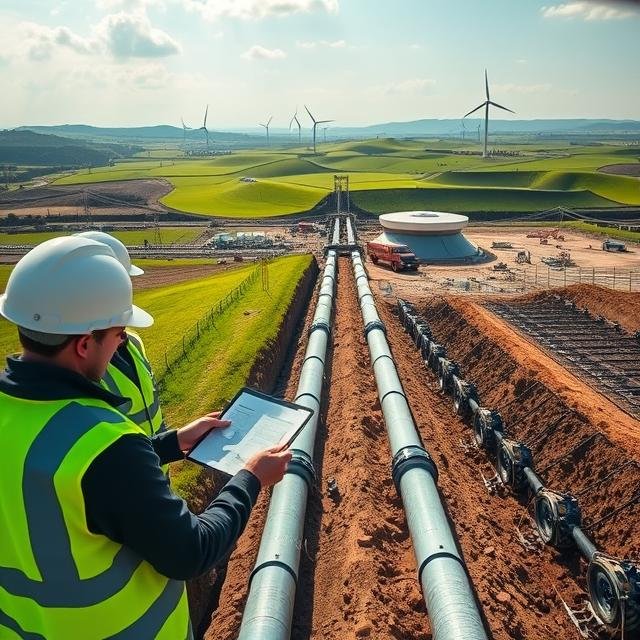Europe is not merely a continent defined by its rich history; it is a dynamic powerhouse of innovation, constantly shaping the future through a multitude of ambitious, active projects. From the icy expanses of the Arctic to the digital clouds of cloud computing, European collaboration and ingenuity are tackling some of humanity’s most pressing challenges. These “European active projects” represent a collective investment in a smarter, greener, and more interconnected future. This article explores the key arenas where these projects are most active, highlighting their goals and profound potential impact.
Table of Contents
The Green Revolution: Pioneering a Sustainable Future
At the forefront of Europe’s active project portfolio is the unwavering commitment to the European Green Deal. This overarching strategy aims to make the EU climate-neutral by 2050, transforming its economy and society to be sustainable and circular. This is not a single project but a catalyst for hundreds of interconnected initiatives.
The Hydrogen Backbone Initiative
A cornerstone of the green transition is the development of clean hydrogen. The European Hydrogen Backbone (EHB) initiative is a massive infrastructure project involving a coalition of leading European energy infrastructure operators. Their goal is to create a dedicated pipeline network for transporting hydrogen across the continent. By repurposing existing natural gas pipelines and building new stretches, the EHB aims to connect emerging hydrogen production hubs, particularly in sun-rich Southern Europe and wind-rich Northern Europe, with major industrial consumption centers. This active project is crucial for decarbonizing industries like steel and chemical production, which are hard to electrify directly.
Horizon Europe’s Climate-Centric Missions
Funded by the monumental €95.5 billion Horizon Europe programme, numerous active projects are targeting specific environmental goals. Missions like “Adaptation to Climate Change” support regions in developing resilience strategies, while “Restore our Ocean and Waters by 2030” funds projects that combat pollution and restore aquatic ecosystems. These are not just research papers; they are active, on-the-ground initiatives deploying new technologies for carbon capture, developing climate-resilient crops, and creating digital twins of the ocean to predict and mitigate changes.
Digital Sovereignty and Innovation: Building the Next Technological Era
Europe is determined to be a leader in the digital age, not just a market for foreign technologies. A suite of active projects is focused on achieving digital sovereignty and driving innovation.
Gaia-X: The Federated Data Infrastructure
Gaia-X is perhaps one of the most ambitious digital projects underway. It is a project for creating a secure, federated data infrastructure for Europe. Instead of being a singular “cloud,” Gaia-X is a set of rules and standards designed to create a transparent, open digital ecosystem where data and services can be made available, collated, and shared in an environment of trust. Companies and governments can participate, knowing their data is protected by strict European regulations like GDPR. It aims to break the dependency on non-European cloud hyperscalers and foster a competitive market for data services, crucial for AI development and industrial IoT.
The European Processor Initiative (EPI)
In a world reliant on semiconductors, Europe is actively reducing its dependency. The European Processor Initiative (EPI) is a strategic project designing high-performance, low-power processor chips for a wide range of applications, from supercomputers to autonomous vehicles. This project is vital for Europe’s technological independence, ensuring that its critical infrastructure and key industries have access to secure and state-of-the-art computing technology not controlled by external entities.
Connecting Continents: Mega-Transport and Infrastructure
Europe’s identity is built on connection, and its active projects in transport infrastructure are testament to this, aiming to create a seamless, efficient, and sustainable network.
The Trans-European Transport Network (TEN-T)
The TEN-T policy is a massive ongoing project to build a continent-wide network of roads, railways, inland waterways, maritime shipping routes, ports, and airports. The goal is to eliminate bottlenecks, modernize infrastructure, and strengthen social and economic ties between member states. Key active components include the Brenner Base Tunnel under the Alps—set to be the world’s longest underground rail link—and the Rail Baltica project, which is integrating the Baltic states into the European standard-gauge rail network, reducing their historical isolation.
The Nordic-Baltic Corridor Digital Twin
Leveraging digital innovation, this corridor is being enhanced by an active “digital twin” project. This involves creating a virtual, dynamic replica of the entire transport corridor. Authorities and logistics companies can use this model to simulate traffic flows, predict delays, optimize logistics, and plan maintenance, dramatically improving the efficiency and reliability of goods movement from the Nordic ports to Central Europe.
Scientific Prestige: Pushing the Boundaries of Knowledge
Europe has long been a global leader in fundamental science, hosting some of the world’s most sophisticated and active experimental facilities.
The Extreme Light Infrastructure (ELI)
Dubbed the world’s largest laser research facility, ELI is a pan-European project with sites in the Czech Republic, Hungary, and Romania. This active project is pushing the boundaries of photonics and laser science. Its ultra-high-intensity lasers are enabling research into areas previously only theorized, from particle acceleration for medicine to studying matter under extreme conditions akin to those inside stars. The knowledge generated here could revolutionize fields from oncology to materials science.
The European Spallation Source (ESS)
Under construction in Lund, Sweden, the ESS is one of the largest active scientific infrastructure projects in Europe. It is a multi-disciplinary research facility based on the world’s most powerful neutron source. Once operational, it will provide scientists with unparalleled insights into the structure and properties of materials at the atomic level. This will accelerate research in pharmaceuticals, energy storage, quantum materials, and engineering, much like CERN does for particle physics.
Conclusion: A Continent Forging Its Future
The landscape of European active projects is vast and varied, yet a common thread binds them: a vision for a future that is sustainable, technologically sovereign, interconnected, and enlightened by scientific discovery. These projects are not undertaken in isolation but are the result of unprecedented transnational collaboration, pooling resources, expertise, and ambition. They demonstrate a profound understanding that the challenges of the 21st century—climate change, digital transformation, global competition—require collective, bold, and active responses. Europe, through these endeavours, is not just adapting to the future; it is actively and deliberately building it.
Informational FAQs
1. How are these massive European active projects funded?
Funding comes from a combination of sources. The primary source is the EU budget, specifically programmes like Horizon Europe (for research and innovation), the Connecting Europe Facility (for transport, energy, and digital infrastructure), and the Cohesion Fund. Additional funding comes from direct investments by member state governments and private sector partnerships.
2. What is the role of collaboration between EU countries in these projects?
Collaboration is fundamental. Most of these projects are too large, complex, and expensive for any single country to undertake alone. The EU provides the framework for cooperation, standardizes regulations, co-funds projects, and ensures that the benefits—economic, scientific, and social—are shared across member states, strengthening the union as a whole.
3. Can non-EU countries or private companies participate in these projects?
Yes, in many cases. Horizon Europe, for instance, is open to association for many non-EU countries. Private companies, including SMEs and large corporations, are often crucial partners in consortia that apply for and execute EU-funded projects, bringing essential technical expertise and innovation to the table.
4. How does a project get the label of a “European Project of Common Interest (PCI)”?
Projects of Common Interest are key infrastructure projects that link the energy, transport, and telecom systems of EU countries. They are selected based on strict criteria: they must have a significant impact on at least two member states, enhance market integration, boost security of supply, and contribute to climate goals. Being listed as a PCI gives projects access to streamlined permits and the right to apply for EU funding from the Connecting Europe Facility.
5. Where can the public track the progress of these active projects?
The European Commission maintains several public portals. The CORDIS website is the primary source for results of EU-funded research projects. Specific directorates-general (e.g., Energy, Transport) also publish updates and maps for major infrastructure projects like the TEN-T network or the Hydrogen Backbone.

